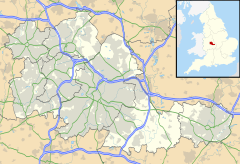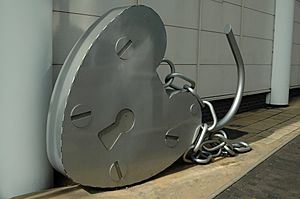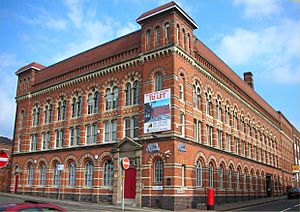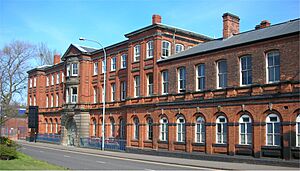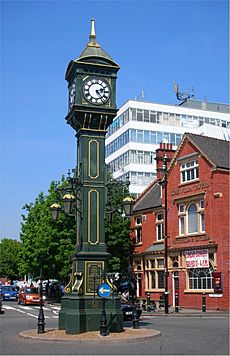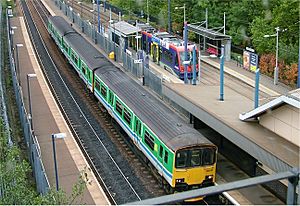Jewellery Quarter facts for kids
Quick facts for kids Jewellery Quarter
|
|
|---|---|
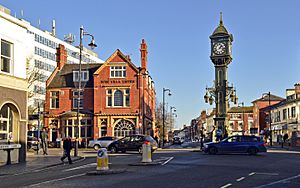 |
|
| Area | 1.07 km2 (0.41 sq mi) |
| Population | 19,000 approx. |
| • Density | 17,757/km2 (45,990/sq mi) |
| OS grid reference | SP072889 |
| Metropolitan borough | |
| Shire county | |
| Metropolitan county | |
| Region | |
| Country | England |
| Sovereign state | United Kingdom |
| Post town | BIRMINGHAM |
| Postcode district | B1, B3 and B18 |
| Dialling code | 0121 |
| Police | West Midlands |
| Fire | West Midlands |
| Ambulance | West Midlands |
| EU Parliament | West Midlands |
| UK Parliament |
|
The Jewellery Quarter (often called The JQ) is a special part of central Birmingham, England. It's in the northwest of the city centre and is home to about 19,000 people. This area covers about 1.07 square kilometres (0.41 square miles).
The JQ is famous for having the largest number of jewellery businesses in Europe. It makes 40% of all the jewellery produced in the UK! It also has the world's biggest Assay Office, which checks and stamps around 12 million items every year. This office makes sure that precious metals like gold and silver are real.
For a long time, the Jewellery Quarter was a leader in new industrial ideas. In the early 1900s, over 30,000 people worked here. But over time, the industry faced challenges from other countries and less demand. So, the area changed into a lively "urban village." It's now a hub for creative businesses, but it still keeps its old charm. Because of its important history, many projects have helped protect its buildings. It's even a special "Anchor Point" on the European Route of Industrial Heritage.
Contents
- Discover the History of the Jewellery Quarter
- Protecting the Jewellery Quarter's Heritage
- The Future of the Jewellery Quarter
- Geography of the Jewellery Quarter
- Exploring the Jewellery Quarter: Tourism
- Industries of the Jewellery Quarter
- Interesting Places to Visit
- Getting Around the Jewellery Quarter
- Learning in the Jewellery Quarter
Discover the History of the Jewellery Quarter
How the Jewellery Quarter Began

Birmingham had goldsmiths as early as 1553. During the 1700s and 1800s, Birmingham grew a lot thanks to the Industrial Revolution. It became a big town that made many things, often from metal. Many large factories and glassworks brought workers from all over Britain. People made things like gilt buttons, cap badges, pins, and small metal toys.
By 1780, there were about 26 jewellers in Birmingham. By the early 1800s, around 12 jewellery companies were making items, employing about 400 people.
In 1746, the Colmore family started to open up land in what is now the Jewellery Quarter. This helped make space for more people. The biggest piece of land was called Newhall. It used to be a rabbit warren! By 1620, a large house called New Hall Manor was built there. This house gave its name to the area.
The area was crossed by three main roads. These roads were very busy with traders and carriages bringing materials from Staffordshire to Birmingham. The Birmingham Canal was finished in 1769, which made these roads even more important for transport.
More houses were built in the 1760s. The Newhall Branch Canal was finished in 1772, which also helped the area grow. By the late 1770s, most of the area was built up with houses. It became a rich neighbourhood with fancy Georgian houses.
Building St Paul's Church and Square
A big boost for the area was when Charles Colmore gave land to build a church. Construction of St Paul's Church and the surrounding St Paul's Square began in 1777 and finished in 1779. Beautiful Georgian houses were built around the square for wealthy middle-class families. Some of these houses, like Nos 12–14, are still there today.
By 1778, most of the Newhall estate was laid out in a grid pattern around St Paul's Church. Two pools were filled in, and the stream that fed them was turned into a canal. The old New Hall manor house was taken down in 1787.
Important people lived in the area. James Watt, who helped invent the steam engine, lived in Regent's Place from 1775 to 1790.
Even though it was a residential area, businesses started to move in. The Birmingham Assay Office was set up in 1773, which helped the industry grow. The Birmingham and Fazeley Canal was built through the south of the area, finishing in 1789. This made it easier to transport goods and materials.
As middle-class families moved out, large factories and workshops were built for goldsmiths and silversmiths. They made things like keys, watch chains, and buckles. Even though buckles went out of style, the jewellery industry still did well. Most jewellery was made in small workshops, not huge factories.
In 1809, Caroline Colmore had a canal arm built from the Birmingham and Fazeley Canal. This helped even more businesses set up in the area. It was called Miss Colmore's Canal.
The number of jewellers dropped in the 1820s because of money problems. But by the mid-1830s, Hockley became the clear centre of the city's jewellery industry.
The Jewellery Quarter Grows Stronger
The Jewellery Quarter's jewellery became better quality and more popular than that made in other cities like Derby and Edinburgh. By the late 1800s, even people in London bought more jewellery from Birmingham. It's thought that by 1850, half of the gold and silver items sold in London shops came from Birmingham. The Quarter made a lot of the fine jewellery for the British Empire. Most jewellers still worked in small workshops with 5 to 50 employees.
Because many jewellers lived and worked in the same area, public services were needed. In 1835, the Key Hill Cemetery was opened. It was for everyone, and sand from the area was used for moulds in metal casting. Later, another cemetery was opened nearby.
In 1832, gas pipes were installed, and by 1840, all jewellers had gas for their blowpipes. This was a big help for their work.
New factories were built, like the Victoria Works (1839-1840), which made steel pen nibs.
In 1845, a group of jewellers from Birmingham visited Buckingham Palace. They wanted Queen Victoria to wear British-made jewellery to promote it. They gave the Queen and Prince Albert beautiful jewellery worth over 400 guineas. They told the Royal couple that 5,000 families in Birmingham depended on the jewellery trade.
More streets were built in the 1840s to create more building plots. By the mid-1800s, the jewellery trade was the most profitable in Birmingham. More people worked in it than any other trade. Boys started apprenticeships at 14, learning the craft.
By 1861, 7,500 people worked in the jewellery trade. By 1880, there were nearly 700 workshops. The price of gold dropped in the 1880s, which helped the trade. New methods like electroplating, invented by George Elkington in the JQ, also helped. The first man-made plastic, Parkesine, was also invented here by Alexander Parkes in 1862.
In 1883, over 2.6 million gold and silver items were sent to the Assay Office to be checked. However, the trade faced a tough time in the 1880s, with many workers losing their jobs.
Recovery and Changes
After the difficult 1880s, jewellers in the Quarter created new groups like the Birmingham Jewellers' and Silversmiths' Association (1887). In 1890, a School of Jewellery and Silversmithing was opened.
As the 20th century began, the Jewellery Quarter grew even more. By 1914, over 20,000 people worked in the trade. The JQ kept its small workshops, with larger factories on the edges making lower-quality jewellery.
During World War I, the Jewellery Quarter thrived because of the demand for military buttons, badges, and medals. But after the war, demand dropped, and fashion changed.
Challenges and Rebuilding
The demand for JQ products peaked in 1920 and then slowly declined. The area was hit hard by the Great Depression. During World War II, factories made war supplies, which made the Jewellery Quarter a target for bombing raids in the Birmingham Blitz. Many buildings were damaged, including St Paul's Church.
After the war, there was a small recovery, but lack of space was still a problem. Larger companies moved out in the 1950s and 1960s. In 1953, a council survey found that 23 acres of land were beyond repair. The council made plans to rebuild the area, but these plans faced opposition.
In 1965, a council plan for redevelopment was approved. It included an eight-storey factory building called the Dockley Centre (now the Big Peg), finished in 1971. But this plan wasn't very successful because rents were too high, and many businesses moved away. So, the council stopped large-scale redevelopment.
New roads, like the Inner Ring Road and Middle Ring Road, were built around the Jewellery Quarter. These roads limited how much the area could expand.
The industry continued to decline after the war due to less demand and competition from other countries. In 1965, 8,000 people worked in 900 firms. By 1985, this dropped to 4,000 people in 600 firms.
To help the area, schemes were started to improve it. Over 300 historic buildings were repaired. In 1987, new housing was built for the first time in a century. But by 1998, many industrial buildings were empty.
In 1998, the Jewellery Quarter Urban Village Framework Plan was adopted. This plan aimed to bring new life to the area by mixing homes and businesses. A partnership was created with the city council, local businesses, and other groups. Their goal is to make the JQ a centre for creative businesses and a place where people want to live.
However, some residents and businesses have said that the council hasn't made enough progress. Manufacturers have also complained that rising rents make it hard for them to stay.
Protecting the Jewellery Quarter's Heritage

Birmingham City Council and English Heritage recognized the Jewellery Quarter's historical importance in the 1970s. In 1971, St Paul's Square was made a "conservation area." This meant it was protected as Birmingham's last Georgian square. Later, the Jewellery Quarter Conservation Area and Key Hill Conservation Area were also created.
In 1998, English Heritage surveyed all the buildings in the JQ. Their report in 1999 said the Jewellery Quarter is a "historic industrial area with international significance." Because of this, the three conservation areas were combined into one big Jewellery Quarter Conservation Area in 2000. Many buildings were also given "listed building" status, meaning they are protected by law.
In 2000, the Newman Brothers Coffin Furniture Factory was given Grade II* listed status. This old coffin factory is now a museum called Newman Brothers at The Coffin Works, which opened in 2014.
In 2008, a council report suggested trying to get the Jewellery Quarter recognized as a World Heritage Site.
The Future of the Jewellery Quarter
Birmingham City Council's plan to make the Jewellery Quarter a hub for creative businesses has brought a lot of private money into the area. Many new projects are being approved. Because it's a conservation area, many projects involve fixing up old buildings, but new ones are also being built.
One big project was the redevelopment of the A. E. Harris factory on Northwood Street. This plan included new homes, shops, restaurants, a medical centre, and an art gallery. It also kept some old buildings and created new streets. The company did this to help secure its future, as it was facing competition from other countries.
Another major project is Newhall Square. This development includes apartments, shops, offices, and a Travelodge hotel. It's built on the site of the old Museum of Science and Industry, which closed in 1997. The plan for Newhall Square was approved in 2006 and cost about £63 million. It includes 234 apartments and a hotel. Construction started in 2007.
St Paul's Square is also a key area for new developments. The £35 million St Paul's Place project includes 148 apartments and office space. It involved restoring the front of the old Thomas Walker building and adding new parts that match the original style. This project also helped improve the lighting and add CCTV in the square.
Smaller projects include fixing up the Chamberlain Building, which now has shops and offices. Spencer Point on Spencer Street is another small development with homes and offices, designed to be very eco-friendly.
On the edge of the Jewellery Quarter is the St Georges development. This is a huge project covering 6.8 acres. It includes 695 apartments, offices, shops, bars, restaurants, and a multi-storey car park. It also has two hotels, including a Ramada Encore hotel. Many old buildings on the site were empty, but some, like the Kettleworks, are being kept. This project started in 2008 and was expected to cost £130 million.
The old Birmingham Mint is also being redeveloped. When the Mint closed in 2003, plans were made to use the site differently. The project includes apartments and offices, keeping the historic front of the building and its tall chimney.
Geography of the Jewellery Quarter
The ground in the Jewellery Quarter is made of a type of sandstone that was very useful for making moulds for metalworking. The area sits on a flat-topped hill. The land slopes down towards Icknield Street and the Birmingham and Fazeley Canal. The highest point is on Warstone Lane.
Before the 1800s, there were two pools in the Jewellery Quarter: Great Hockley Pool and Little Hockley Pool. Both have since been filled in.
In 2008, experts warned that the Jewellery Quarter could be at risk of flooding. This is because the water level underground is rising, partly because heavy industries that used a lot of water have left the area.
Exploring the Jewellery Quarter: Tourism

The Jewellery Quarter is not just an industrial area; it's also a popular place for tourists. Many workshops still look like they did in the 1800s.
Birmingham City Council started promoting tourism in the JQ in the 1980s. They wanted to improve the area, create a museum, and make it a rival to other jewellery centres. They improved car parks and street furniture. They also made a guide for shop designs to keep the area looking good.
The council also tried to tell more people about the Jewellery Quarter. They published articles in newspapers and magazines. They also made leaflets to help people find the area.
Many manufacturers agreed to let the public see how jewellery was made. A "Factory Tours" guide was published. The council also planned a shopping guide, but it was never produced.
In 2003, three metal sculptures were put on lamp posts at key entrances to the Jewellery Quarter. These sculptures, made by a local artist, were created in the JQ itself.
The Museum of the Jewellery Quarter is a popular attraction. It was created when the Smith & Pepper jewellery firm closed in 1981, leaving everything inside. It's now part of the Birmingham Museum & Art Gallery. In 2008, TripAdvisor named it the third best free tourist attraction in Europe!
The JQ also has several art galleries. The Royal Birmingham Society of Artists moved to St Paul's Square in 2000. St. Paul's Gallery is the largest commercial art gallery outside London.
There are also two special walking trails. The Findings Trail has 30 pavement slabs with stainless steel plaques that look like hallmarked tags. The Charm Bracelet Trail is shaped like a giant bronze charm bracelet. A padlock at the bottom of Newhall Hill marks the start of this trail.
Industries of the Jewellery Quarter
Today, about 700 jewellery-related businesses still work in the Jewellery Quarter. Around 400 of these are jewellery manufacturers, making 40% of all British jewellery. They make jewellery for the public, for shops, and for wholesale. The JQ has the highest number of dedicated jewellers in Europe. Vittoria Street is home to the Jewellery teaching centre for the Birmingham Institute of Art and Design.
Many old industrial buildings have been refurbished, like the Argent Centre. The JQ has also become home to PR firms, media companies, software companies, and architects.
The silver and gold made here in the 1800s and early 1900s were very high quality and had their own special stamp (hallmark). These items are now valuable collectibles. In the 1800s, chains were also made, some for watches and others for industrial use.
Another big industry in the JQ was the pen trade. The Quarter had the world's first mass producer of pen nibs, which made pens much cheaper. At its peak, 5,000 workers made 1.5 billion pen nibs a year!
Many famous sporting awards are still made here today. The trophy for the winners of the Wimbledon Ladies Singles tournament was made in the JQ. Thomas Fattorini Ltd., based here, designed and made the original FA Cup trophy. They also make the Lonsdale and Commonwealth boxing belts.
Whistles were also invented and made in the Jewellery Quarter. Joseph Hudson made the first football referee whistle in 1878 and invented the police whistle in 1883. Hudson even made whistles for the RMS Titanic! Since 1870, about a billion whistles have been made here.
Coffins and coffin parts were also made in the area, mainly at the Newman Brothers Coffin Furniture Factory. This factory, built in 1892, made metal coffin fittings. They even made coffin parts for the funerals of famous people like Sir Winston Churchill and Princess Diana. The company closed in 1999.
Coins were also made in the Jewellery Quarter by the Birmingham Mint, which operated from 1850 to 2003. By 1889, it was the biggest private mint in the world!
Interesting Places to Visit
As more tourists visit, many buildings have been restored and are now local landmarks. St Paul's Square is Birmingham's only remaining Georgian square. Its church was attended by early industrialists. It later became filled with workshops but has now been restored. It's one of the few open spaces in the JQ.
Two other open spaces are the Warstone Lane and Key Hill Cemeteries. Both are no longer used for burials but are protected historic sites. Key Hill is where many important people from Birmingham are buried.
The Chamberlain Clock stands at the junction of Vyse and Frederick Street with Warstone Lane. It was built in 1903 to celebrate Joseph Chamberlain's visit to South Africa.
Newhall Street was once home to the Museum of Science and Industry. Most of the museum buildings were taken down in 1997, but some parts remain and will be part of the new Newhall Square development. Many of the museum's exhibits moved to Thinktank.
Another landmark is the Big Peg, an eight-storey building completed in 1971. It has been refurbished into studio offices for arts, media, and creative businesses. The Big Peg Gallery hosts art exhibitions.
Getting Around the Jewellery Quarter
The Jewellery Quarter has its own train and tram stop, called Jewellery Quarter station. It opened in 1995 for trains and 1999 for trams. It's on the line to Birmingham Snow Hill station. An entrance to Snow Hill station was opened on Livery Street in 2011, making it easier to get to the JQ.
Birmingham's canal network runs through the south of the Jewellery Quarter. The Birmingham & Fazeley Canal was finished here in 1789. An old canal arm, once called Miss Colmore's Canal, has been filled in, but you can still see where it was. The canal is now used for fun activities, not industry.
The Jewellery Quarter has many narrow streets. But it's surrounded by wide roads built after World War II. These include Great Charles Street Queensway to the south and Icknield Street to the northwest. Several bus services also run through and around the area.
Learning in the Jewellery Quarter
The oldest school in the Jewellery Quarter is the Municipal School for Jewellers and Silversmiths. It's now part of the Birmingham Institute of Art and Design at Birmingham City University. The school was founded in 1888 and moved to its current building in 1890. The building has been expanded and renovated over the years.
The Birmingham campus of The College of Law is also in the JQ, housed in old industrial buildings. Abbey College Birmingham, an independent school for students aged 14–19, is located near St Paul's Square.
University College Birmingham plans to build a new campus on Legge Lane. The old City of Birmingham Fire Brigade station on Albion Street has been turned into a children's day nursery. The Birmingham Music School is also in the area, adding to the growing music scene.
Parking in the Jewellery Quarter is mostly pay-and-display. There are also some cheaper or free parking spots on side streets.


